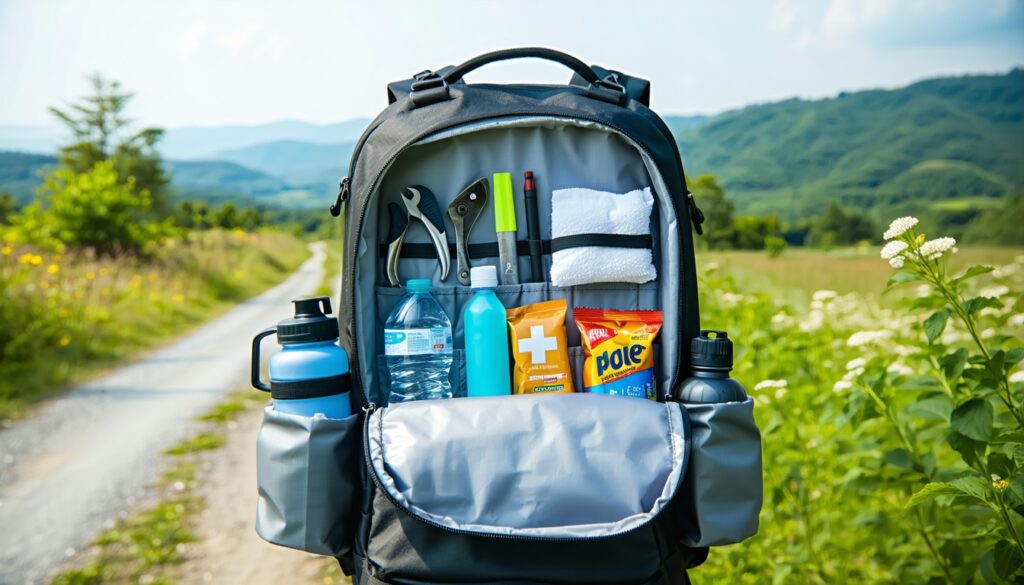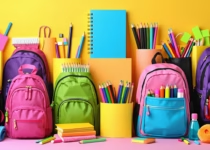How to Pack Tools, Snacks, and Gear in a Bike Backpack Efficiently

Essentials for a Cycling Adventure
When preparing for a cycling adventure, knowing which essentials to pack can make all the difference in ensuring a successful outing. Here, we will cover the necessary items for a half-day bike ride, homemade energy options to keep riders energized, and alternative food storage solutions to keep everything organized and accessible.
Half-Day Bike Ride Essentials
For a half-day bike ride, cyclists should prioritize carrying the following items to maintain energy levels, ensure safety, and enhance overall comfort:
| Essential Item | Purpose |
|---|---|
| Hydration Supplies | Maintain energy levels and prevent fatigue |
| Nutrition and Snacks | Keep energy steady throughout the ride |
| Repair Tools | Address minor mechanical issues |
| Safety Supplies | Be prepared for emergencies |
| Comfort Items | Enhance the overall riding experience |
Cyclists should not overlook the importance of hydration, nutrition, and having the right tools.
Homemade Energy Options
Cyclists can prepare their own energy options for rides, allowing for controlled ingredients and cost savings. Here are some popular homemade options:
- Energy Gel Flasks: Great for carrying homemade energy gels and liquids, providing a cheaper alternative to commercial brands.
- Skratch Paper 2.0 or Slick Wrap: A durable and non-stick parchment-lined aluminum foil ideal for wrapping homemade snacks.
| Homemade Snack | Description |
|---|---|
| Energy Gels | Easy to consume during rides, customizable to personal taste. |
| Granola Bars | Nutritious and filling; can be made at home. |
Additionally, cyclists can explore using eco-friendly wrapping solutions like:
- Bee’s Wrap: Reusable and sustainable, perfect for wrapping various snacks.
- Stasher Bags: Versatile for packing and organizing snacks without single-use plastic waste.
Alternative Food Storage Solutions
Keeping food secure and fresh during a ride is essential. Here are some alternative storage solutions:
- Bee’s Wrap: Ideal for wrapping sandwiches, pancakes, and more.
- Stasher reusable bags: Great for snacks and easy to clean and store after use.
Using these methods not only supports healthier snacking but also contributes to environmentally friendly practices while cycling.
Integrating these essentials and tips into packing can help cyclists efficiently take tools, snacks, and gear in a bike backpack, ensuring that they are well-prepared for their cycling adventures.
Preparing for the Journey
Embarking on a cycling adventure requires meticulous planning. This section covers essential aspects that every cyclist should consider before hitting the road.
Route Research Importance
Researching the intended route is crucial for determining what to pack when learning how to pack tools, snacks, and gear in a bike backpack. Key factors to explore include:
- Climate and weather patterns
- Availability of towns and eateries
- Accessibility to water sources and resupply points
Understanding these elements can significantly influence the items one decides to bring.
| Route Factor | Consideration |
|---|---|
| Climate | Check for temperature ranges and potential weather changes. |
| Town Frequency | Plan resupply points based on distances between towns. |
| Water Sources | Identify known water access points on the route. |
Planning Your Camp Kitchen
A well-organized camp kitchen can make meal preparation efficient during your cycling journey. When assembling your cooking gear for bikepacking trips, consider nesting most components within your cooking pot to save space. This strategy not only optimizes space but also keeps your kitchen essentials organized.
| Camp Kitchen Essentials | Description |
|---|---|
| Cooking Pot | A lightweight pot for boiling water and cooking foods. |
| Portable Stove | Compact stove for easy cooking on the go. |
| Utensils | Lightweight utensils, ideally nesting to save space. |
| Food Containers | Use collapsible or stackable containers for easy storage. |
Calculating Water and Food Needs
Proper hydration and nutrition are vital for sustaining energy during bikepacking. On average, plan for 2-6 liters of water storage and enough space for 2-4 days’ worth of food, depending on the nature of the trip. Cyclists should consider that cycling consumes significantly more calories.
| Item | Recommended Amount |
|---|---|
| Water | 2-6 liters, depending on climate and distance |
| Food | 2-4 days’ worth, selected based on caloric needs |
Remember to incorporate a variety of snacks that can provide efficient energy while on the move. Taking the time to thoughtfully prepare for the journey will pay off in the long run, ensuring an enjoyable and successful adventure.
Packing Tools for Maintenance
When embarking on a cycling adventure, ensuring that the right tools are packed for maintenance is crucial. A well-prepared cyclist can manage unexpected repairs with ease. Here’s a look at the essentials to include in any biking toolkit.
Basic Repair Kit Essentials
A basic repair kit is an indispensable part of any cyclist’s backpack. Carrying the right tools and spare parts enables quick fixes during a ride. Here’s a list of must-have items to include in a repair kit:
| Item | Purpose |
|---|---|
| Multi-Tool | Used for tightening bolts, adjusting rear derailleurs, and quick fixes. |
| Spare Inner Tube | Essential for replacing flat tires, especially on long rides. |
| Tire Levers | Helps in removing and replacing tires when fixing flats. |
| Master Chain Link | Crucial for chain repairs, as chains can break on the trail. |
| Tubeless Tire Plug Kit | Recommended for those with tubeless tires, allowing for quick patching of punctures. |
Including these items can help resolve the most common mechanical issues that may occur, ensuring a smoother journey and minimizing disruptions.
Safety Equipment Considerations
Safety should be a priority for any cyclist. Carrying appropriate safety gear along with repair tools enhances preparedness in case of emergencies. Here are essential safety items to pack:
| Item | Purpose |
|---|---|
| First Aid Kit | For treating minor injuries like cuts and scrapes. |
| Whistle | Useful for signaling for help in case of an emergency. |
| Satellite Messenger | Allows communication with the outside world for emergencies. |
| Headlamp or Flashlight | Important for visibility if riding in low-light conditions. |
| Reflective Gear | Enhances visibility to other road users, especially at night. |
Packing a comprehensive array of tools and maintaining a solid safety kit will prepare any cyclist for potential challenges on their biking adventures. With these essentials included in their bags, riders can focus on enjoying the journey ahead.
Optimizing Space in Your Backpack
A well-organized bike backpack can make all the difference on a cycling adventure. By optimizing space, cyclists can ensure they have all the necessary tools, snacks, and gear without overwhelming their load. Here are some effective strategies for maximizing backpack space.
Sharing Gear and Tools
One practical approach to saving space is sharing gear with a cycling partner. By dividing items like tools, tents, cooking systems, cutlery, and even personal items like toothbrushes, cyclists can lighten their loads and use the limited space more effectively. This strategy not only reduces bulk but also fosters camaraderie during the ride.
Utilizing Compression Sacks
Compression sacks are a game-changer for cyclists looking to save space in their backpacks. These sacks are ideal for compressing clothing, rain gear, and sleeping bags, significantly reducing their overall volume. By utilizing compression sacks, cyclists can gain extra room for other essential items and maintain organization in their packs.
| Item Type | Size Before Compression | Size After Compression |
|---|---|---|
| Clothes | 15 liters | 7 liters |
| Rain Gear | 8 liters | 3 liters |
| Sleeping Bag | 12 liters | 5 liters |
Streamlining Packing Efficiency
Effective packing techniques can drastically improve the way space is utilized in a bike backpack. Here are some tips to streamline efficiency:
-
Remove Excess Length: Trimming items such as toothbrushes and straps can help fit items into tight spaces more effectively.
-
Choose Packing-Friendly Food: Opting for food items that pack neatly and using stackable, collapsible gear can optimize packing strategies. Avoiding single-use plastics helps in conserving space while being environmentally friendly.
-
Set Up a Base Camp: Establishing a base camp allows for a more organized packing strategy. Cyclists can keep essentials handy and easily accessible, eliminating the need to repack frequently.
For more tips on organizing your gear, visit our article on best practices for organizing your gear in a bike backpack. By implementing these strategies, cyclists can optimize space in their backpacks and ensure a more enjoyable and efficient ride.
Mountain Biking Specific Essentials
When preparing for a mountain biking adventure, it’s vital to pack the right snacks and tools to ensure a successful ride. Here, we’ll explore some essential on-the-go snacks and crucial tools that every mountain biker should have in their backpack.
On-the-Go Snacking
Maintaining energy levels on the trail is important, so carrying the right snacks is key. Recommendations for snacks include:
| Snack Type | Suggested Options | Nutrition Benefits |
|---|---|---|
| Energy Chews | SaltStick Fast Chews | Great for electrolyte replenishment |
| Trail Mix | Nuts, dried fruit, seeds | Provides healthy fats and quick energy |
| Protein Bars | High-protein granola bars | A good source of energy and recovery |
It’s generally advisable for riders to carry at least 2 liters of water during their rides to stay hydrated.
Essential Tools for Mountain Biking
Equipping a bike backpack with the essential tools can save a ride that may encounter mechanical issues. Here is a list of crucial items to carry:
| Tool | Purpose |
|---|---|
| Hand Pump | Check and pump tire pressure for optimal ride |
| Tubeless Tire Plug Kit | Seals punctures quickly without needing inner tubes |
| Master Chain Link | A spare to facilitate chain repairs if broken |
| Multi-Tool with Chain Breaker | Useful for various repairs and adjustments on the trail |
By including these snacks and tools in their backpack, mountain bikers can tackle routes with confidence. Effective packing of essentials can lead to smoother rides and enhanced enjoyment on the trails. For tips on how to pack tools, snacks, and gear efficiently, check out our guide on how to pack tools, snacks, and gear in a bike backpack.
Bikepacking Packing Tips
When preparing for a bikepacking adventure, efficient packing is crucial for a smooth experience. Here, we will explore essential strategies for weight distribution, item placement, and organizational tools that will help cyclists maximize space in their backpacks.
Weight Distribution Techniques
Proper weight distribution is vital for balance on the bike. Keeping heavier items close to the back and near the center of gravity can enhance stability. Here are some tips:
- Heavy Items First: Place bulky tools and snacks low and towards the center of the backpack.
- Light Items on Top: Lighter gear, such as clothing and sleeping bags, should be packed on top for easy access.
- Weight Distribution Table:
| Item Type | Placement |
|---|---|
| Tools | Bottom center |
| Snacks | Upper center |
| Clothing | Top |
| Sleeping Gear | Top |
Strategic Item Placement
Organizing items strategically can make it easier to find essentials while on the go. Here’s how to optimize placement:
- Frequent Use: Items used frequently, such as snacks or maps, should be easily accessible in outer pockets.
- Emergency Gear: Essentials like first aid kits and communication devices should be placed where they can be reached quickly.
- Repair Kit: Ensure your repair and spares kit is well-organized and easily accessible to tackle mechanical issues efficiently during rides.
Organizational Tools for Efficiency
Using organizational tools can significantly enhance packing efficiency. Consider the following:
- Compression Sacks: Utilize compression sacks to minimize the volume of clothing and sleeping bags. These can reduce bulk and maximize space.
- Packing Cubes: Use packing cubes to keep similar items together for quick access.
- Tool Roll or Pouch: Organize tools and repair items in a dedicated pouch or roll to avoid clutter.
- External Mesh Pockets: Take advantage of backpacks with external mesh pockets for water bottles or items that need to be easily accessible.
Organizing packing may not always be space-efficient due to varying factors like resupply distances and climates. Taking these techniques into consideration can help any cyclist prepare for their next adventure, ensuring that they have what they need when they need it while traveling on two wheels.


